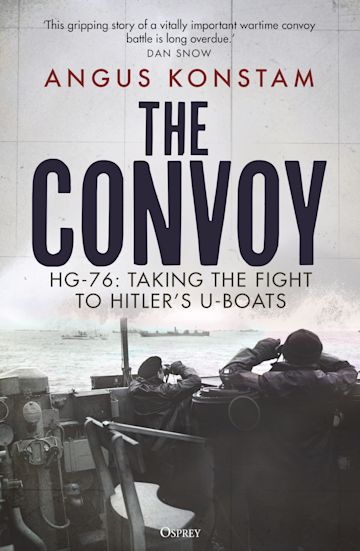The Convoy: HG-76: Taking the Fight to Hitler’s U-Boats
- By Angus Konstam
- Osprey Publishing
- 320 pp.
- Reviewed by Larry Matthews
- January 26, 2024
How a Liverpool-bound British flotilla outmaneuvered Nazi subs.

During World War II, German submarines sank approximately 3,000 Allied ships, merchant and naval. The U-boats ranged far out into the Atlantic Ocean and patrolled the East Coast of the United States. Even today, you can find old lookout towers along the beaches of the Mid-Atlantic.
One of the reasons the Germans were so successful in their undersea warfare was their strategy of attacking supply convoys with groups of U-boats known as wolf packs. In these clusters, five to seven U-boats employed pack-like tactics to attack and cause maximum damage to Allied shipping.
Angus Konstam is a British historian with more than a hundred books to his credit, a fellow of the Royal Historical Society, and, oddly enough, an expert on pirates. He’s renowned for his knowledge of the Royal Navy and has written in The Convoy a crackling, impressively researched account of a large Allied supply fleet that sailed from Gibraltar to Liverpool in December 1941, hounded by U-boats all the way. Konstam writes:
“Between June and October these U-boats sank almost 1.4 million tons of shipping — a stunning total of 274 merchant ships. That amounted to 65 times the displacements of the U-boats doing the hunting.”
The Germans were sinking Allied ships faster than new ones could be built. The mastermind of the wolf-pack strategy was Admiral Karl Dönitz, who believed that using groups of U-boats for attacks was the most effective way to inflict serious harm on the enemy.
There was a shortage of U-boats, too, though, partly because they were being sunk or disabled by the Royal Navy. So, Germany initiated a crash program to churn out more, some being pressed into service before they were certified seaworthy. While Hitler was only partly sold on the wolf-pack idea — thinking that spreading the submarines around the area of battle was a better tactic — Dönitz was convinced pack formation was the answer.
All of this comes into the story told in The Convoy, as do the exploits of a British naval officer named Johnny Walker, who commanded the warships guarding the 32 merchant vessels in this particular convoy. He had some ideas of his own about how to deal with Nazi wolf packs.
The book begins with a history of both sides and a look at how the convoy was assembled. These sections take on a slow, term-paper feel as Konstam sets the scene. Once the players are in place, however, the ships leave Gibraltar, and Walker and his warships try to stay ahead of the Germans, the narrative takes off.
Ships maneuver, depth charges are dropped, vessels are sunk. Men die in frigid waters. Cargo precious to the war effort is lost. Of the five U-boats sent to attack Walker’s convoy, three are destroyed by the British Navy. But the Germans have successes, too; a British carrier is torpedoed and sent to the ocean floor. At times, The Convoy reads like a novel:
“The key moment came at 20.30 when the merchant ships in the convoy fired off their snowflake flares. If Endrass in U-567 was astern of the centre of the convoy when the flares erupted, then he’d have seen a solid line of ships a couple of thousand yards ahead of him. It was a U-boat commander’s dream.”
Day by day, hour by hour, Konstam takes the reader along on this dangerous journey. In the end, Walker, once an overlooked officer, changes the strategy for combating U-boats by being pro-active, seeking them out, and drawing first blood before the submarines can do their worst. It works. Most of his convoy arrives safely in Liverpool, and it’s seen as a British victory. Of course, as students of WWII — who may be the ones best suited to this dense, detailed book — already know, there will be long years of fighting ahead before the Third Reich is finally vanquished.
Larry Matthews is the author of Take a Rifle from a Dead Man and other books.
